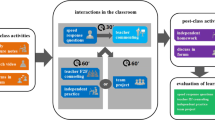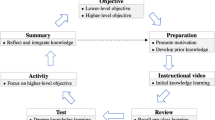Abstract
Many professional development programs aim to improve student outcomes by enhancing teacher competencies. Effective evaluation of these programs requires a clear delineation of the competencies to be gained. A competency model was developed to evaluate the impact of a teacher professional program that aimed to improve teachers’ ability to effectively implement technologically engaged modules in a flipped classroom setting. Competencies were identified via participatory evaluation techniques and assessments were aligned to the competencies. The competency of teachers in the knowledge, skills, and abilities needed for creation and delivery of effective flipped lessons can be tracked using a radar graph to guide tailored professional development.


Similar content being viewed by others
References
America’s Health Rankings Annual Report. (2018). Retrieved from August 15, 2019 https://www.americashealthrankings.org/explore/annual/measure/Overall/state/MS.
Baker, J. (2000). The “classroom flip”: Using web course management tools to become the guide by the side. In: 11th International conference on college teaching and learning, April 12–15, 2000 Jacksonville, FL.
Bann, C. M., McCormack, L. A., Berkman, N. D., & Squiers, L. B. (2012). The health literacy skills instrument: A 10-item short form. Journal of Health Communication, 17(Suppl3), 191–202.
Batalden, P., Leach, D., Swing, S., Dreyfus, H., & Dreyfus, S. (2002). General competencies and accreditation in graduate medical education. Health Affairs, 21, 103–111.
Bishop, J. L., Verleger, M. A. (2013). The flipped classroom: a survey of the research. In: 120th ASEE annual conference & exposition, June 23–26, 2013 Atlanta, GA.
Blömeke, S., & Delaney, S. (2012). Assessment of teacher knowledge across countries: A review of the state of research. ZDM, 44, 223–247. https://doi.org/10.1007/s11858-012-0429-7.
Bromme, R., & Steinbring, H. (1994). Interactive development of subject matter in the mathematics classroom. Educational Studies in Mathematics, 27(3), 217–248.
Butt, A. (2014). Student views on the use of a flipped classroom approach: evidence from Australia. Business Education & Accreditation, 6, 33–43.
Chetty, R., Friedman, J. N., Rockoff, J. E. (2013). Measuring the impacts of teachers II: Teacher value-added and student outcomes in adulthood. Cambridge, MA: National Bureau of Economic Research, Working Paper No. 19424. https://doi.org/10.3386/w19424
Clark, K. R. (2015). The effects of the flipped model of instruction on student engagement and performance in the secondary mathematics classroom. Journal of Educators Online, 12, 91–115.
Dreyfus, S. E. (2004). The five-stage model of adult skill acquisition. Bulletin of Science, Technology & Society, 24, 177–181. https://doi.org/10.1177/0270467604264992.
Enochs, L. G., & Riggs, I. M. (1990). Further development of an elementary science teaching efficacy belief instrument: A preservice elementary scale. School Science and Mathematics, 90, 694–706. https://doi.org/10.1111/j.1949-8594.1990.tb12048.x.
Flipped Learning Network. (2014). The four pillars of F-L-I-P. Flipped Learning Network Hub. Retrieved from August 8, 2019 https://flippedlearning.org/definition-of-flipped-learning/.
Fulton, K., & Britton, T. (2011). STEM teachers in professional learning communities: From good teachers to great teaching. Washington, DC: National Commission on Teaching and American’s Future.
Harrington, D. T., Miner, T. J., Ng, T., Charpentier, K. P., Richardson, P., & Cioffi, W. G. (2015). What shape is your resident in? Using a radar plot to guide a milestone clinical competency discussion. Journal of Surgical Education, 72, e294–e298. https://doi.org/10.1016/j.jsurg.2015.04.005.
Helmer, O. (1967). Analysis of the future: The Delphi method. Santa Monica, CA: The RAND Corporation.
Keister, D. M., Larson, D., Dostal, J., & Baglia, J. (2012). The radar graph: The development of an educational tool to demonstrate resident competency. Journal of Graduate Medical Education, 4, 220–226. https://doi.org/10.4300/JGME-D-11-00163.1.
Lage, M. J., Platt, G. J., & Treglia, M. (2000). Inverting the classroom: A gateway to creating an inclusive learning environment. Journal of Economic Education, 31, 30–43. https://doi.org/10.2307/1183338.
McCormack, L., Bann, C., Squiers, L., Berkman, N. D., Squire, C., Schillinger, D., et al. (2010). Measuring health literacy: A pilot study of a new skills-based instrument. Journal of Health Communication, 15, 51–71. https://doi.org/10.1080/10810730.2010.499987.
Mortensen, C. J., & Nicholson, A. M. (2015). The flipped classroom stimulates greater learning and is a modern 21st century approach to teaching today’s undergraduates. Journal of Animal Science, 93, 3722–3731. https://doi.org/10.2527/jas.2015-9087.
National Academies of Sciences, Engineering, and Medicine. (2016). Science teachers’ learning: Enhancing opportunities, creating supportive contexts. Washington, DC: The National Academies Press. https://doi.org/10.17226/21836w.
National Research Council. (2013). Next Generation Science Standards: For states, by states. Washington, DC: The National Academies Press. https://doi.org/10.17226/18290.
Notebaert, A., Barnard, M., Meyer, E., Compretta, C., Allen, D., Stray, S., Taylor, J., Sullivan, D., Rockhold, R. (2018). Science teaching excites medical interest: A teacher professional development program in Mississippi. Journal of STEM Outreach, 1. Retrieved from August 25, 2019 https://www.jstemoutreach.org/article/5066-science-teaching-excites-medical-interest-a-teacher-professional-development-program-in-mississippi.
Richardson, V. (1996). The role of attitudes and beliefs in learning to teach. In J. Sikula (Ed.), Handbook of research on teacher education (2nd ed., pp. 102–119). New York: Macmillan.
Sawada, D., Piburn, M. D., Judson, E., Turley, J., Falconer, K., Benford, R., & Bloom, I. (2002). Measuring reform practices in science and mathematics classrooms: The Reformed Teaching Observation Protocol. School Science and Mathematics, 102(6), 245–253.
Shulman, L. S. (1986). Those who understand: Knowledge growth in teaching. Educational Research, 15, 4–14.
Thompson, A. G. (1992). Teachers’ beliefs and conceptions: A synthesis of the research. In D. A. Grouws (Ed.), Handbook of research on mathematics teaching and learning: A project of the National Council of Teachers of Mathematics (pp. 127–146). New York: Macmillan.
Tschannen-Moran, M., & Hoy, A. W. (2001). Teacher efficacy: Capturing an elusive construct. Teaching and Teacher Education, 17, 783–805. https://doi.org/10.1016/S0742-051X(01)00036-1.
Vargas, R., Zhang, L. (2017). 2015 Mississippi Youth Risk Behavior Survey Report. Office of Health Data and Research. Mississippi State Department of Health. Office of Health Data and Research, Mississippi State Department of Health. Retrieved from August, 15, 2019 https://msdh.ms.gov/msdhsite/_static/resources/7429.pdf.
Wieman, C. (2015). A better way to evaluate undergraduate teaching. Change: The Magazine of Higher Learning, 47, 6–15. doi.org/10.1080/00091383.2015.996077
Acknowledgements
The STEMI investigators would like to thank the teachers who have participated in the STEMI program. Their dedication and professionalism have a daily impact on the lives of Mississippi students, and it is inspiring to work with them.
Funding
This work was supported by a Science Education Partnership Award (SEPA) grant, Grant Number 8 R25GM129212-03 from the National Institutes of General Medical Sciences (NIGMS), National Institutes of Health (NIH). Its contents are solely the responsibility of the authors and do not necessarily represent the official views of the NIGMS or NIH.
Author information
Authors and Affiliations
Corresponding author
Ethics declarations
Conflict of interest
All authors declare that they have no conflict of interest.
Ethical approval
All procedures performed in studies using human participants were in accordance with the ethical standards of the institutional research committee (University of Mississippi Medical Center Institutional Review Board Protocol #2016–0109) and with the 1964 Helsinki declaration and its later amendments or comparable ethical standards.
Informed consent
Institutional Review Board approval was granted prior to the initiation of this project and informed consent was obtained from all individuals involved in the development of the competency model.
Additional information
Publisher's Note
Springer Nature remains neutral with regard to jurisdictional claims in published maps and institutional affiliations.
Rights and permissions
About this article
Cite this article
Barnard, M., Dehon, E., Compretta, C. et al. Development of a competency model and tailored assessment method for high school science teachers utilizing a flipped learning approach. Education Tech Research Dev 68, 2595–2614 (2020). https://doi.org/10.1007/s11423-020-09782-5
Published:
Issue Date:
DOI: https://doi.org/10.1007/s11423-020-09782-5




